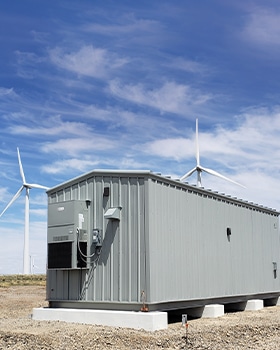Designing Substation Control Buildings for Rough Conditions

Trachte’s prefabricated substation control buildings are vital to the interconnection of essential infrastructure. These applications can include electrical utility, renewable energy, power distribution centers, and data center interconnection.
Trachte prefabricated buildings are typically engineered based on customer specifications and state regulatory codes. Buildings are engineered to mitigate risk from environmental factors and extreme weather conditions. Here are 10 factors companies must consider when designing a prefabricated substation control building.
- Location: Control buildings should be situated close to the substation equipment, and in an area that is safe and accessible for all personnel. The location should also consider any zoning or land-use regulations that may apply as well as the location’s geography. If the final site location is a coastal or dusty environment, building manufacturers can apply a special protection package to the exterior wall and roof sheeting to mitigate the effects of harsh climate conditions while protecting the building and extending its use.
- Environmental considerations: The control building should be designed to withstand local weather conditions, including wind, snow, rain, seismic, and temperature extremes. Manufacturers utilize high-grade steel in the construction of prefabricated buildings to enhance structural integrity. Steel is durable, long-lasting, entirely recyclable, and makes for a cost-effective solution. It can also be modified easily, paving the way for even greener infrastructure.
- Security: Control buildings contain sensitive equipment and data, so security considerations must remain a priority when designing a control building. This may include access control systems, surveillance systems, and other security measures to prevent unauthorized access. Some building manufactures offer additional security shielding for ballistics, electromagnetic pulse (EMP), and fire resistance.
- Size: The size of the control building should reflect the size of the substation and the amount of control and electrical equipment that needs to be protected. It should be large enough to accommodate all necessary equipment and provide adequate space for personnel to comfortably move around and complete tasks. The size of the building should also comply with the National Electrical Code requirements for clearance and egress. Consult your local jurisdiction for more information.
- Electrical and mechanical requirements: The control building should be designed to provide adequate electrical and mechanical systems to support the substation equipment. This may include power and lighting systems, HVAC systems, fire suppression systems, and customer provided equipment such as relay racks, control and monitoring equipment, or switchgear. HVAC systems are sized to the interior and exterior environment of each building — calculations are completed based on the building dimensions, interior equipment installed, and the final geographic location.
- Proper insulation and sealing: Ensure buildings are well-insulated and sealed to prevent water infiltration, air leakage, and heat loss during extreme weather events. This helps maintain comfortable interior conditions and prevents damage to the building envelope. A standard 2:12 roof pitch, for example, allows for adequate water run-off and snow shedding when compared to flat or minimally sloped roof designs.
- Maintenance: Prefabricated buildings can be designed with an exterior or interior steel sheeting that includes a maintenance-free Polyvinylidene Fluoride (PVDF) resin coating. Spraying or dip coating this thin layer of PVDF material to the sheeting’s surface provides protection against environmental factors such as UV radiation, moisture, and corrosive chemicals. PVDF coating enhances the durability of the metal sheeting contributing to the overall structural integrity of the building.
- Future expansion: The control building should be designed to allow for future expansion as the substation grows and new equipment is added. This is especially important as new solar fields come online and connect to the grid.
- Regulatory requirements: Before design can begin, make sure to research all regulatory requirements that apply to the design and construction of the control building. Requirements include compliance with local building codes, national safety standards, and environmental regulations. Upon completion, all control buildings should receive professionally engineered and stamped structural drawings and calculations.
- Adopt green building practices: Incorporate sustainable design principles into building projects, where applicable, to mitigate the long-term impacts of climate change and extreme weather events. This includes utilizing energy-efficient materials, renewable energy sources, and green infrastructure solutions.
The design of a prefabricated substation control building involves careful consideration of factors such as location, environmental conditions, security, size, and regulatory requirements. Trachte utilizes high-grade steel and advanced engineering techniques that ensure structural integrity and resilience to extreme weather events. Implementing proper insulation, maintenance practices, and green building principles can further enhance the durability and sustainability of these essential infrastructure components.
The author is Laura Longston, Marketing Coordinator at Trachte. Written for the May/June Issue of North American Clean Energy.
